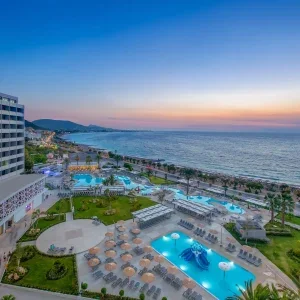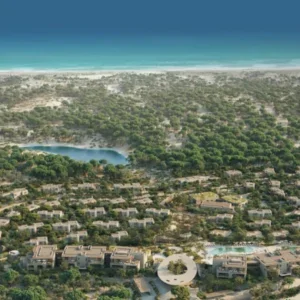Modern Indian hospitality began with the Great Eastern Hotel. Founded around 1840, just as the British Raj was brushing down its red coat and preparing to swallow the subcontinent whole, it would quickly come to represent the pinnacle of Calcutta high society. It became the first Indian hotel to install electricity – and that was just the start of its allure. As one observer wryly observed of the hotel’s Victorian heyday, this was a place where “a man could walk in at one end, buy a complete outfit, a wedding present, or seeds for the garden, have an excellent meal, a double, and if the barmaid was agreeable, walk out at the other end engaged to be married”.
Yet if the erstwhile glamour of the Great Eastern is surprising enough, even more striking is how it has endured. Calcutta may now be Kolkata, and the British Raj may have vanished for good, but apart from an eight-year gap from 2005, the Grand Eastern has greeted guests non-stop for nearly two centuries. And, if you know much about Indian hospitality, this feels appropriate. Like the Grand Eastern, after all, the industry has long been built on extravagance. Not every hotel can promise you a husband by checkout, but sophisticated brands like Taj have long dominated the subcontinent’s hospitality. Even today, these luxury hotels represent a market share worth over $23bn, according to MMR.
Now, however, things are changing. Older Indian hospitality lingers on, but now they are jostling for space with leaner mid-market alternatives. This shift is easy to understand. With a booming entrepreneurial class, operators can no longer hope to thrive on splendour alone. Even so, Indian hospitality is not necessarily destined for success. From a continued lack of trained staff to broader societal challenges, the industry has plenty to deal with. Get it right, though, and it could provide jobs for millions – and a warm place to stay for a billion more.
Subpar subcontinent
Foreigners have always been intoxicated by India, and if one can appreciate all the subcontinent has to offer, this sentiment makes sense.
“The country’s history goes back 2,500 years,” says Sudeep Jain, the south-west Asia managing director at InterContinental Hotels (IHG). “Some of those monuments are still preserved.” That is true of the Taj Mahal, of course, but also countless other mosques, temples and forts. From there, there are India’s natural delights. “India has always been a country with diverse offerings, be it mountains or plains, beaches or backwaters,” says Suma Venkatesh, executive vice-president of real estate and development at Indian Hotels Company Limited (IHCL), the company behind Taj hotels.
These wonders have naturally helped shape Indian hospitality too. With so much to show, the industry has grown steadily over the years, and is now 7.5% of GDP, according to a report by Hospitality Industry in India. Operators have typically focused their attention on where foreigners gravitate. Beyond major cities like Mumbai and Delhi, Professor Dipra Jha explains that the so-called ‘Golden Triangle’ is another area of focus. “The area around Delhi, the Taj Mahal at Agra and the city of Jaipur has been around for a long time,” says Jha, an expert in Indian hospitality at Washington State University. Certainly, this is a point supported by even a cursory glance at what is available, from the Sujan Rajmahal Palace, hosted at a Jaipur castle, to a smattering of Oberois at Agra and Delhi.
Yet if blockbuster properties continue to excel – Taj aims to balloon its portfolio by 36% over the next five years – other corners of hospitality have habitually lagged behind. That is particularly clear the further down the price ladder you travel. IHG’s Holiday Inn brand only got its first new-build Indian property in 2010, for instance, while Hilton only opened a DoubleTree near the Taj Mahal in 2014. In part, these trends can be understood culturally. As Jain explains, many Indians have tended to stay with family or friends while traversing the country. Arguably more crucial, however, is the issue of economics. As recently as the 1990s, barely 1% of India’s population had clambered into the middle class, their progress stymied by ineffectual top-down economic policies and the vagaries of the caste system.
Mid-market magic
Set amid laurels and rice paddies, kissed by the Indian Ocean and just steps from a ruined Portuguese fort, the Holiday Inn Goa Candolim vividly showcases a new Indian hospitality. Since it opened last August, guests have been able to luxuriate at one of the property’s 106 guest rooms, each boasting balconies and air conditioning as standard. Want some company and punters can venture to the Atrium, a bar offering custom cocktails. For guests who need to work or workout, the Candolim offers both a business centre and a 24-hour gym.
At first glance, then, the Candolim seems to follow the elegant model of Oberoi and Raj. But look at the prices and your perception soon shifts. You can currently book a night at the Candolim for around $100, while kids under 12 stay for free. To put that into perspective, an evening at the famous Taj Mahal Palace in Mumbai will set you back over $300. This difference, emphasises Jain, speaks to a hospitality built for Indians, by Indians and with the Indian mindset. Nor is the Goa property unique. On the contrary, IHG plans to open 39 new properties in India over the next few years, with 27 coming under the mid-market Holiday Inn banner. Other operators are close behind. Hilton, for its part, has unveiled a number of Garden Inn hotels across India. The mid-market craze has even reached IHCL, where Venkatesh and her team are currently expanding their Ginger brand. Described by the executive as a “lean luxe” offering, Ginger properties will offer convenient, comfortable hospitality without blowing the budget.
These hotels differ from more old-fashioned offerings in other ways too. Though global cities like Mumbai still secure investment, Jha says that tier two and tier three towns are increasingly receiving new openings. Ginger, for its part, now boasts a footprint at Sanand (in Gujarat) and Aurangabad (in Maharashtra), among other less famous destinations. More to the point, Jha argues that economics can once again be conscripted into explaining this trend. Beyond the increasing numbers travelling for business, “India has a very robust domestic tourism market,” he says. “Because of that, India needs a large supply of non-luxury accommodation.”
A fair point: according to some measures, around half of all Indians are now middle class. Not that higher wage packets are the only way of understanding the rise of brands like Holiday Inn in India. For starters, Jain highlights the country’s huge diaspora, some 18 million strong, many of whom need somewhere comfortable and inexpensive to stay while visiting family or attending religious festivals. In a similar vein, Jha claims that cultural events are also attracting adventurous foreigners without the cash or inclination to stay at a five-star resort “sipping martinis all day”. More broadly, both Jain and Jha are keen to underline India’s improved infrastructure, which encourages brands to develop beyond traditional urban centres.
Incredible India
Between the jaunty economy and shiny new roads, it is easy to imagine that India’s mid-range boom can last forever. But Venkatesh strikes a note of caution. “On the operating side, the biggest challenge hotels face is the ability to hire and retain talent,” she says, adding that India’s economic boom means there are plenty of other jobs people could take outside of hospitality. Jha agrees, suggesting “there’s a lot to be done” to train Indians to Western standards. That is doubly true, Jha argues, for mid-market hotels. Though elite brands are old hands at educating staff in wine pouring or room cleaning – Jha himself has worked at the Oberoi Centre of Learning and Development – he warns that India’s antiquated education system is too focused on rote learning and not enough on critical thinking.
All the same, there are signs that even here, India is advancing. At IHG, for instance, Jain and his colleagues are increasingly focused on IHG Academy, the brand’s bespoke training programme. Jha makes a similar point, describing how bodies like the Institute of Hotel Management, a hospitality school with campuses across India, are training a new generation of Indian hoteliers. In fact, Jain argues that one day soon the subcontinent could actually start spreading its expertise overseas. “I think you will start seeing Indian owners from India owning hotels overseas,” he says, “which means the export of capital in the hospitality sector.” Given how much Indians have already done to transform their own hotel industry, this feels entirely apt.






